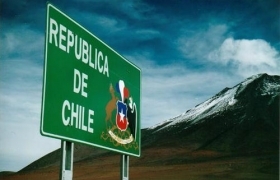A key source of drug precursor chemicals, and with domestic cocaine consumption that’s among the highest in Latin America, Chile is quietly increasing its counter-narcotics efforts.
In two particular low-key moves in early October, the Chilean administration of Sebastian Piñera upped its anti-drug efforts with the announcement of the Northern Border Plan, and the purchase of an unknown quantity of Israeli Unmanned Aerial Vehicles (UAVs, or drones). The plan, which will come into effect in 2013 at a cost of $76 million, has one simple, but very important objective, as Interior and Public Security Minister Rodrigo Hinzpeter put it: to stop drugs entering Chile.
Though it has not been explicitly stated, the drones look set to form a central part of the Plan, in light of Defense Minister Andres Allemand’s declaration that they would become operational within the same time frame. In addition, Allamand announced in January that Chile’s new satellite, FASat-Charlie, launched in December last year, could be incorporated into the fight against trafficking.
All of these moves fall under Piñera’s four-year Plan Secure Chile, a drive by the president to address crime in general, which includes specific elements to combat the country’s drug problem through both enforcement measures and treatment programs for users.
Sharing a border with two of the world’s top cocaine producers — Bolivia and Peru — makes Chile’s involvement in the narcotics trade a virtual inevitability. However, unlike its northern neighbors, Chile is strictly a drug-consuming nation. With Brazil and Argentina, it accounts for two thirds of cocaine consumption in Latin America and the Caribbean. Alone, it makes up 10 percent, according to the UN’s 2011 World Drug Report.
Not only does its status as a relatively wealthy consumer market make the country an attractive target for drug traffickers looking to expand their markets, but the country’s geographical location and superior infrastructure make it a major transit point for drugs, particularly those coming from Bolivia. Minister Hinzpeter said last year that, of the 140 overland drug routes into Chile, 106 come from Bolivia. Furthermore, of the nearly 7 tons of cocaine seized abroad on Chilean ships between January 2009 and July 2011, the vast majority was found in Bolivian containers that had passed through Chile’s ports.
Confonting Chilean authorities is also the prospect of having to control and track the movement of precursor chemicals from Chile heading north. With one of the largest petrochemical industries in the region, Chile is a prime source of chemicals used in the production of illegal narcotics. The·2011 International Narcotics Control Strategy Report (INCSR) highlighted the use of chemicals of Chilean origin in processing coca base in Peru and Bolivia, and the shipment of Chilean ephedrine to Mexico, where it is used to produce methamphetamine.
As the INCSR notes, Chile’s police have been far more active in recent years with regards to narcotics control, taking part in 20 percent more drug-related operations between March and September 2010 than in the same period in 2009, while arrests for drug offenses were up 28 percent. This coincides with recent reports that crime is on the rise in Chile, with the number of crimes reported in 2011 up 10.6 percent on the previous year.
Despite the rising level of interdictions and arrests, Chile·has not covered all bases in terms of combating crime and drug trafficking. The INCSR notes the lack of funding provided to the national drug control council, CONACE (now SENDA), for its monitoring of petrochemicals. Chile’s prosecutors are also underfunded, leaving them struggling to cope with rising crime.
However, Chile remains unlikely to experience any serious growth in the influence of drug trafficking organizations. It boasts some of the strongest political institutions in the region and the lowest level of corruption, according to Transparency International’s 2011 ratings. It lacks, furthermore, any notable domestic criminal structures.
Chile can’t change its neighbors, however, and neither the domestic demand for cocaine nor the supply from Bolivia and Peru seem likely to abate in the near future.

